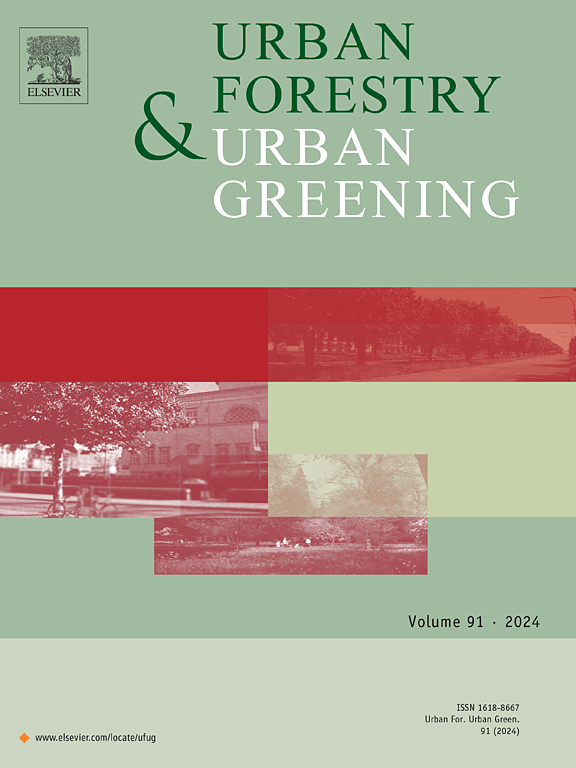以自然地点为基准,评估香港绿化屋顶的生物多样性
IF 6.7
2区 环境科学与生态学
Q1 ENVIRONMENTAL STUDIES
引用次数: 0
摘要
随着城市化的加剧,在有限的城市空间内维持和加强生物多样性变得越来越具有挑战性和重要性。城市绿色屋顶已经成为扩大绿色空间和保护生物多样性的重要机会。本研究以可比较的自然地点为基准,评估香港绿化屋顶的生物多样性。在一年的时间里,我们监测了八个绿色屋顶和八个自然地点的物种组成,重点关注了四个生物类群:植物、蝴蝶、鸟类和蜜蜂/黄蜂。研究结果表明,虽然绿色屋顶可以促进城市生物多样性,但与自然栖息地相比,它们往往不足,特别是在支持本地植物物种和蝴蝶方面。在自然地点,约有三分之二的植物是本地植物,而绿化屋顶上的植物主要是外来物种。总体而言,绿化屋顶实现了66. %的植物物种丰富度和27. %的蝴蝶物种丰富度。自然立地和绿化屋顶在主要植物科和生命形式的分布上也有很大差异。研究结果表明,蝴蝶丰富度和蝴蝶多样性与多种植物性状之间存在较强的相关性。该研究强调了城市绿化屋顶战略规划的必要性,包括确定重点保护物种,优先考虑本地植物物种,提高栖息地复杂性。研究结果为寻求在紧凑型城市中培育具有弹性和多样性的生态系统的城市规划者和政策制定者提供了见解。本文章由计算机程序翻译,如有差异,请以英文原文为准。
Evaluating the biodiversity of green roofs in Hong Kong by benchmarking natural sites
As urbanization intensifies, maintaining and enhancing biodiversity within limited urban spaces becomes increasingly challenging and critical. Urban green roofs have emerged as an important opportunity for expanding green spaces and conserving biodiversity. This study evaluated the biodiversity of green roofs in Hong Kong by benchmarking comparable natural sites. Over the course of a year, we monitored species composition at eight green roofs and eight natural sites, focusing on four biological groups: plants, butterflies, birds, and bees/wasps. The findings indicate that while green roofs can contribute to urban biodiversity, they often fall short compared to natural habitats, particularly in supporting native plant species and butterflies. At the natural sites, about 2/3 of plants are native, whereas those on the green roofs are mainly alien species. Overall, green roofs achieved 66 % of the plant species richness and 27 % of the butterfly species richness observed at natural sites. The natural sites and green roofs also differ greatly in the distributions of main plant families and life forms. The findings reveal strong and significant correlations between butterfly richness and butterfly diversity and a variety of plant traits. This study highlights the necessity for strategic planning of urban green roofs, including identification of the key species for conservation, prioritization of native plant species, and enhancement of habitat complexity. The findings offer insights for urban planners and policymakers seeking to foster resilient and diverse ecosystems within compact cities.
求助全文
通过发布文献求助,成功后即可免费获取论文全文。
去求助
来源期刊

Urban Forestry & Urban Greening
FORESTRY-
CiteScore
11.70
自引率
12.50%
发文量
289
审稿时长
70 days
期刊介绍:
Urban Forestry and Urban Greening is a refereed, international journal aimed at presenting high-quality research with urban and peri-urban woody and non-woody vegetation and its use, planning, design, establishment and management as its main topics. Urban Forestry and Urban Greening concentrates on all tree-dominated (as joint together in the urban forest) as well as other green resources in and around urban areas, such as woodlands, public and private urban parks and gardens, urban nature areas, street tree and square plantations, botanical gardens and cemeteries.
The journal welcomes basic and applied research papers, as well as review papers and short communications. Contributions should focus on one or more of the following aspects:
-Form and functions of urban forests and other vegetation, including aspects of urban ecology.
-Policy-making, planning and design related to urban forests and other vegetation.
-Selection and establishment of tree resources and other vegetation for urban environments.
-Management of urban forests and other vegetation.
Original contributions of a high academic standard are invited from a wide range of disciplines and fields, including forestry, biology, horticulture, arboriculture, landscape ecology, pathology, soil science, hydrology, landscape architecture, landscape planning, urban planning and design, economics, sociology, environmental psychology, public health, and education.
 求助内容:
求助内容: 应助结果提醒方式:
应助结果提醒方式:


